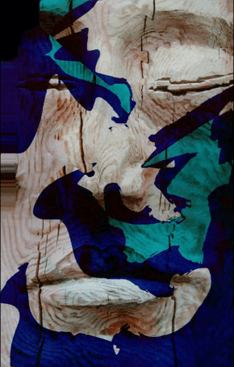Where does art belong today in a world saturated with digital images?
Where does art belong today in a world saturated with digital images?
The biennial art circulation market with its fairs, auctions and institutions is one possible answer. Another could be the virtual-algorithmic space, a space already awash with millions of illustrators, photographers, painters, designers, models, graphic designers, tattoo artists, nail artists, makeup artists, stage designers, and street artists. But are all of these products, objects, and images truly Art or mere tropes[1]?
Today the label of Art has become art without the capital letter and it is a confusing conglomerate, a rhizome without a center, and a liquid structure that overflows and spills with its mysterious flows, causes, and sediments. In the past, Art was divided by the medium, with defined limits and practices, a model of catagorising art that has since been dismantled during the 19th and 20th centuries. By contrast in the virtual space, Art has become a total entity, the place for the emergence of contemporary culture.
This dimension of the art-total has permeated bodies; Beuy’s[2] idea has come true consciously or unconsciously – every person is a creator/artist. This can be acredited to the development of two technologies: the production of technical images (Flusser[3]), and telecommunications (Manovich[4]). According to Flusser, the world has been transformed into particles that are imperceptible to the human eye. Experience has been reduced to these particles. To access this new wealth of information, it must be revealed through a technical “apparatus”. As silver nitrate reveals an image on photosensitive paper, different systems acting to agglomerate all the particles are required to build the necessary models.
The universe of particles is, in turn, transmissible thanks to the development of tools, which allow the spatial-temporal displacement of these particles from one place to another through the transmission of waves, magnetic fields, and photons. The transmission of particles and the ability to transduce them into images, sounds, and texts is possible thanks to the development of different digital media currently at our fingertips.
Going back in time to review the history of media, we discover photography. At last, it was possible to produce accurate images without the need for a skilled artist by following these steps: load a camera with photosensitive paper, and develop the image using a chemical reaction in a dark room. Leap forward 100 years to the invention of video. Using a point that travels at a specific speed in front of a screen allows for the creation of electronic images. To generate this image three conditions must be met: circuits with photo sensors capable of translating light into electrical pulses, a magnetic tape to capture these electrical oscillations and transmit them, and a circuit that allows for the transformation of electrical pulses into light waves through a vacuum tube.
More recently, these means of image production (photo, video and machine based images) have been fused, along with other tools into a single device – the digital computer – capable of containing virtually all other devices. The ‘macro device’ GesamtkunstWerkzeug condenses knowledge of optics, mathematics, physics, and computer science to create something unique.
The computer was first envisioned by Ramon Lull in the 12th century in his book Ars generalis ultima[5]. Lull proposed the creation of a machine-like device capable of bringing together cross-cultural forms of religious devotion through the combination of each of its parts with the intention of stopping the holy wars between Christians and Muslims. Although Lull’s ideas did not end the crusades, they did find a way into the modern computer, opening possibilities of new utopias, world building, the creation of new disciplines, and knowledge sharing, while ultimately bringing bodies together in virtual spaces.
Reflecting on these infinite possibilities currently available thanks to computers was the focus of the Digital Art Residency[6] hosted by Jugend und Kulturprojekt e.V. (JKPeV)[7] in Dresden. This project began as an open call to all artists who wanted to meet and think together about the possibilities, challenges, fears, and uncertainty related to the digital flow of information and its relation to computers.
Going back to the original question: Where does art belong in today’s society? Or more specifically: where does art occur in the digital age when everything can be automated, mediated, or artificially produced?
In 2003, Rick Silva presented his Complex Net Art Diagram, 2003[8]. opening the way to ideas of post-internet art. This paradigm shift emphasises the relationship between users, computers, structures of power, and the digital surveillance that now dictates our online presence.
In contrast to Silva, the Digital Art Residency’s diagram explains where art happens in the following manner:

philosophers thinking the digital world + a safe space for experimentation with technical resources + totally heterogeneous artists.
While Silva sees art as happening in the digital realm between two computers communicating with each other, the Digital Art Residency sees art as being formed between multiple individuals and digital networks through complex interactions. In other words, the Digital Art Residency considers art as the melding of digital devices with the community.
This combination germinates an ecosystem where multiple perspectives overlap to create an obtuse image, a coherent uncertainty that palpates the complex porosities of the present. Building on the history of Art, the history of computers opens a vertical window to the complexities of collaborative creation, sharing, and emotions. It is with this in mind that the exhibits ONE AND INFINITY – THE DIGITALISATION OF THE HUMAN MIND and METAMORPHOSIS OF THE MIND were conceptualised.
To introduce this exhibit, we need to make a leap into speculation. How does a Korean economist narrate the end of the world? How many conversations and affections are born from coming together? Is it possible to hide one’s identity? How does a Russian-Ukrainian feel when she is forced to leave her home? Can the political polarities of the world be reversed? If automatic writing were a digital collage, what would it look like?
These questions emanated during our collaborative meetings. Projects were born from the conjunction of ideas which in turn became part of this exhibit. Each project emerged from dialogue, the exchange of experiences and opinions, and the forging of divergent constellations of approaches to multiple realities.

Collective Drawing Experience by Mia-Ann Böhm, Laura Michelle Schubert, Michael Siegmund
The first project to emerge from this process was the Collective Drawing Experience. Mia-Ann Böhm, Laura Michelle Schubert, and Michael Siegmund met regularly using a digital application called Magma, which allows for collaborative drawing on an online canvas. Böhm, Schubert, and Siegmund utilised Magma as a meeting place where illustrations act as a pretext to community bonding and opened the door to complex discussions about authorship, belonging, production, and the importance of collective creations. The project was a space for exchange, where reflections on the uncertainty of our online presence are interpreted as the unconscious image behind the image.
As an exercise in liberating the unconscious through digital media, the artist Oleksandra Kulikovska, envisions surrealist automatism[9] as a digital collage. Her work builds a whirlwind of images that follow one after the other without stopping, like accelerated thoughts and fragments of ideas all travelling at the speed of light.

Melting by Oleksandra Kulikovsk 2022
Kulkovska’s fragments aroused the interest of Jakyeong Jeong, who expands on the idea by building a projection of the apocalypse. Jeong’s images do not move quickly. Instead, they are patient and rest in observation in an act of timeless meditation. While Jeong’s discovery happens in a distant universe, its constant presence inescapably affects ours.
Belal’s Someday Soon or Just Happening Today opens a window to an alternate reality, which becomes visible through complex resolution. Similar to 15th century painters and 19th century photographers (Enlightenment Formalism), the film industry and algorithms limit three-dimensional possibilities to realism. In contrast, Belal uses 3D virtual space to create the illusion of infinity and to change the polarities of natural forces. His work features aerial whales, submerged cars, and shapeless anthropomorphic figures that inhabit inexhaustible spaces. Belal stretches the imagination, presenting current realities as experimental dis-/utopias by examining scientific thought under the microscope.
Expanding on Belal, Augusto Gerardi, builds a visual history of evolution through artificial intelligence, using the wikicommons image repository. Using a sky-scraper as a model, Gerardi’s recreation undermines, in a Borgian[10] way, the basic foundations of encyclopaedism by putting tension on the relationship between artificial and natural as well as subjects and objects. In an age of increasing reliance on sophisticated, encyclopaedic tools, Gerardi brazenly questions whether the sciences even have the capacity to define and classify something so complex as nature.
Ukrainian refugee and performance artist Anna Mukhanova opens a window, releasing her spirit to the deepest voices of her being. Through a video performance, Mukhanova addresses her feelings of rootlessness which are like an eternal migration and where stars converge with destroyed buildings and mountains, becoming deserts, seas, and rivers. Mukhanova’s work embodies the present tragedy of war in her home city of Odessa. She tells a story about exile and the fears and longings it brings. The physical exile is only one part of the story. The deepest exile for Mukhanova is the estrangement of the soul from the body.
“Hiden Identities: a collective experience of AR” was developed as part of the growing awareness and criticism for the identities and indexes that govern society. Based on facial recognition technology (Spark Ar), the project is a series of masks designed collaboratively by Geradi, Böhm, and Kulikovska that interrogates the complex and differering forms of surveillance that immerse current society in algorithmic tyranny. A mask inspired by the film Les yeux sans visage[11] floats in virtual space, transforming, as well as mirroring, in real time viewers’ faces. The transformed faces are a reflection on the self-production of images and the digital processes that mediate identity.
This heterotopic constellation of practices are the emergent forms of the present. The only place with the ontological capacities to understand these practices is the space of art. And the only way in which they can be conjured is through the construction of a safe space where uncertainties, traumas and longings can materialize. The Digital Art Residency and the exhibits ONE AND INFINITY – THE DIGITALISATION OF THE HUMAN MIND and METAMORPHOSIS OF THE MIND are the efforts of JKPeV to build a safe space where art and digital techniques work as a bridge to understand the complexities of each person, using art as the tool to mediate this complexity and being able to freely share it.
Links to the art works http://www.digital-art-residencies.kultur-centrale.de/artworks-e/
[1]https://www.merriam-webster.com/dictionary/trope [2]https://www.goethe.de/ins/fr/de/kul/dos/beu/22222261.html [3]https://www.upress.umn.edu/book-division/books/into-the-universe-of-technical-images [5]https://archive.org/details/bub_gb_rG_yINh8V1gC/page/n31/mode/2up [6]http://www.digital-art-residencies.kultur-centrale.de/ [7]https://www.jkpev.de/en/ [8]https://anthology.rhizome.org/simple-net-art-diagram [9]https://www.tate.org.uk/art/art-terms/a/automatism [10]https://blogs.commons.georgetown.edu/modernities-working-group/files/2013/07/borges_the-library-of-babel.pdf [11]https://archive.org/details/eyes-without-a-face-1960-restored-720p-hd
Article by Augusto Gerardi and Doreen Siegmund
Digital Art Residencies Exhibition
@Full Moon Gallery
05 February – 05 March 2023
Vernissage | 05 February 2023 | 20:00


